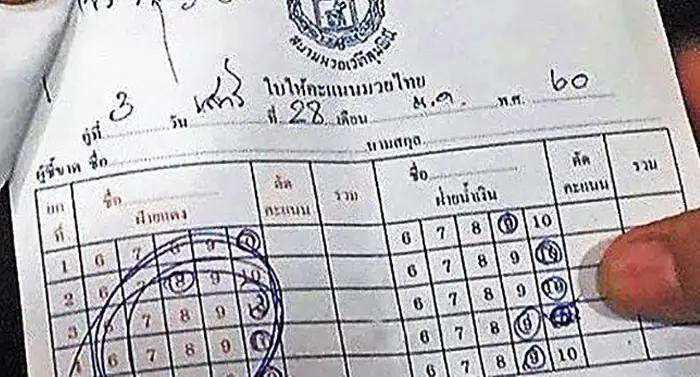Many western fighters and fans get confused when it comes to muay thai fight decisions. I’ve seen them think one fighter is up on the scorecards, but the other competitor walks away with the win. This guide aims to reduce some of the confusion around rules and scoring in muay thai.
The truth is muay thai is scored differently than boxing, kickboxing, and mixed martial arts (MMA) striking, so it’s understandable that many get confused. You don’t want to go into your first fight thinking you’re winning, only to lose on points then look like an idiot protesting the judges.
In this Article
What Are the Rules of Muay Thai?
- Muay thai bouts take place in a square ring up to 24ft wide
- Fighters compete at the same or similar skill level and weight class
- Before every fight, the two competitors jump over the top rope if male or under the bottom rope if female (a sexist tradition, I know)
- The two fighters pay homage and seal the ring by walking around the ring in a counter-clockwise circle, stopping at each corner and bowing. They can also perform a wai kru, a traditional dance passed down from your muay thai trainer.
- Fighters use hand wraps and 6oz-12oz gloves depending on weight class
- Muay thai matches consist of five 3-minute rounds with 2-minute rests in between rounds
- When the fight starts, both fighters may strike with their hands, feet/shins, knees, and elbows hence the name art of eight limbs
- Unlike boxing and some kickboxing rulesets, fighters may clinch. From the clinch, fighters may throw knees and elbows and even do sweeps
- Fighters may also catch kicks and off balance their opponent with sweeps
- A fighter wins if they knock out their opponent, the referee stops the fight because they deem a fighter unfit to finish the match (TKO), or if the match goes the distance and he/she has more points on the judges scorecards than their opponent
How Does Muay Thai Scoring Work?
Each round is scored out of 10 points, similar to boxing’s 10-point must. Points are scored based on a fighter’s performance in the following criteria: effective technical aggression, ring generalship, and pure aggression. These judging criteria will be explained below.
The winner of the round receives 10 points and the loser receives 9, 8, or 7 based on their performance. A warning results in losing a point.
- 10:10 – An even round
- 10:9 – One winner and the following don’t apply
- 10:8 – One clearly dominant winner OR one winner of a round with the loser being counted once in that round
- 10:7 – One clearly dominant winner with the loser being counted once in that round OR one winner of a round with the loser who has been counted twice in that round
Unlike boxing which is scored on individual rounds, Thai fights are scored as a whole. All points are totaled out of 50. This means that even if you’re down a couple of rounds you can still win on points in the later rounds.
Effective Technical Aggression: 70%
This is the most important factor in scoring and winning a round. Points for effective aggression are awarded based on the number of clean blows a fighter lands with power an accuracy. It doesn’t matter what direction he is moving in forward, backward or sideways.
What striking techniques score the most points? It doesn’t matter if you’re throwing kicks, punches, or knees. What matters is that the strikes you throw land hard on their targets without being blocked.
There are a few ways to demonstrate a powerful strike. The first way is if your strike makes your opponent show visible or audible damage. eg. they grunt after a liver shot. Next is if your opponent is slightly off balanced and forced to take a step to stay upright after you connect. Third, if your striking or sweep technique completely off balances your opponent and they hit the ground. Last is if your opponent is knocked to the floor with concussive force and is forced to take an eight-count.
This also means that you should try to not appear hurt when you take a hit. If you go down for the count, get back up ASAP and be ready for the ref. If you look hurt, you’ll lose points. The ref might even stop the fight.
Ring Generalship: 20%
Points are awarded for a fighter’s ability to dominate his opponent, control the action, and stopping his opponent from performing. Controlling the pace of the fight is important if you want to score points for ring generalship.
You need to show skill in your defense, evasion, and counterattacks. That means checking kicks, slipping and blocking punches, and utilizing footwork to create angles and force your opponent to keep up.
Your ability to jam up and stop your opponent’s strikes is very important here.
Pure Aggressiveness: 10%
Pure aggressiveness is the least important aspect of muay thai scoring, but these points still add up. Points are awarded to the fighter who forces the action and makes their opponent run away. That means really controlling the pace and moving forward.
Hopefully, this post helped clear up some confusion. The best way to score points in a muay thai fight is to land clean and strong blows while controlling the pace and stopping your opponent from doing damage.
It’s harder than it sounds, but at least now you know what judges are looking for. This information should be helpful if you want to watch fights in Bangkok.
Sources:






I don’t even know how I ended up here, but I thought this post was
good. I don’t know whho you are but certainly you arre going
to a famous blogger if you aren’t already 😉 Cheers!